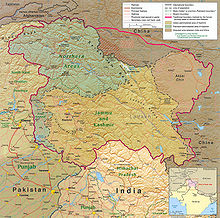1965 Indo-Pakistani war
| Indo–Pakistani War of 1965 | |||||||
|---|---|---|---|---|---|---|---|
| Part of the Indo–Pakistani war and conflicts | |||||||
 Geopolitical map of Kashmir provided by American CIA, ca. 2004 |
|||||||
|
|||||||
| Belligerents | |||||||
|
|
|
||||||
| Commanders and leaders | |||||||
|
(President of India) (Prime Minister of India) (Chief of the Army Staff) (Vice-Chief of the Army Staff) (GOC-in-C, Western Command) (GOC-in-C, Northern Command) (GOC-in-C, Southern Command) (GOC-in-C, XI Corps) (Chief of the Air Staff) (Chief of the Naval Staff) |
(President of Pakistan) (Cdr-in-Chief, Army) (Commander, I Corps) (Commander, IV Corps) (GOC, 12th Infantry Division) (GOC, 7th Infantry Division) (Cdr-in-Chief, Air Force) (Cdr-in-Chief, Navy) (DG Naval Intelligence) (Commander, 25th Destroyer Sqn) |
||||||
| Strength | |||||||
|
700,000 Infantry
628 Artillery
|
260,000 Infantry 552 Artillery
|
||||||
| Casualties and losses | |||||||
|
Neutral claims
Indian claims
Pakistani claims
|
Neutral claims
Pakistani claims
Indian claims
|
||||||
Eastern Front
700,000 Infantry
700+ aircraft
720 Tanks
628 Artillery
260,000 Infantry
280 aircraft
756 Tanks
552 Artillery
Neutral claims
Indian claims
Pakistani claims
Neutral claims
Pakistani claims
Indian claims
The Indo-Pakistani War of 1965 was a culmination of skirmishes that took place between April 1965 and September 1965 between Pakistan and India. The conflict began following Pakistan's Operation Gibraltar, which was designed to infiltrate forces into Jammu and Kashmir to precipitate an insurgency against Indian rule. India retaliated by launching a full-scale military attack on West Pakistan. The seventeen-day war caused thousands of casualties on both sides and witnessed the largest engagement of armored vehicles and the largest tank battle since World War II. Hostilities between the two countries ended after a United Nations mandated ceasefire was declared following diplomatic intervention by the Soviet Union and the United States, and the subsequent issuance of the Tashkent Declaration. Much of the war was fought by the countries' land forces in Kashmir and along the border between India and Pakistan. This war saw the largest amassing of troops in Kashmir since the Partition of British India in 1947, a number that was overshadowed only during the 2001–2002 military standoff between India and Pakistan. Most of the battles were fought by opposing infantry and armoured units, with substantial backing from air forces, and naval operations. The war exposed Pakistan's inadequate standards of military training, its misguided selection of officers, poor command and control arrangements, poor intelligence gathering and bad intelligence procedures. In spite of these shortcomings, the Pakistan Army managed to fight the larger Indian Army. Many details of this war, like those of other Indo-Pakistani Wars, remain unclear.
...
Wikipedia
